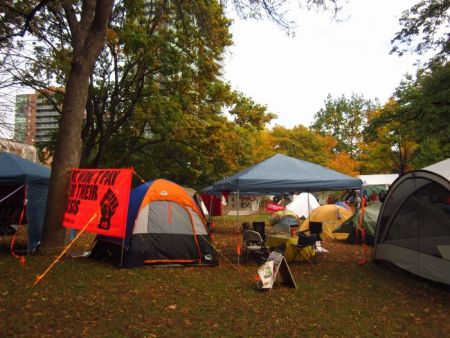Toronto - For almost five years the corner of Dupont and Spadina was a hub for local music, art, and activism. The Duspa, Nuspa, and the Gild community houses were located here before they were sold and the residents were forced to find new homes. A tiger mural on the side of a dilapidated shed still stands while the memory of alley festivals and choir practice still hangs thick in the air.
In a city where rent is high and affordable studio space is slim, a growing number of people are adopting a DYI ethic and turning their homes into make shift galleries, jam spaces, and workshops. While Occupy Toronto is an ambitious attempt at collective living, many of the issues which have arisen at it have been occurring at collective houses for years.
“Combining communal and residential modes is important,” says Demian Carynnyk, founder of Community Noise, a collective that works to connect and promote these alternative communities. “It brings people together, connects our everyday lives to empowering possibilities, and makes creative space and activity affordable.”
These spaces are as varied and eclectic as the people who live in them. The Soybomb Collective throws parties with local bands, holds a weekly pay-what-you-can documentary series in support of the G20 legal defense fund and invites Food Not Bombs to use their space every second Sunday. Food Not Bombs collects surplus food that would otherwise go to waste and prepares vegetarian meals for events and bi-monthly meals at Allan Gardens. Another collective house located at Dupont and Gladstone has attempted to open a community space in their ground level storefront with zines, workshops, readings, and music.
Communal living is also a delicate balance where open communication, regular house meetings, and structure is crucial. Urban farming advocate and co-founder of the About Face Collective Natalie Amber believes communal living can foster love, respect, and acceptance if one is intentional about it. “Just as these positive attributes can be gained from learning to live cooperatively with others in close quarters, their opposing qualities can manifest just as strongly,” she said.
Similarly, the Occupy Toronto camp has built community through general assemblies, camp chores, shared meals, and workshops. It also faces many challenges as it tries to bring together people from different political and socio-economical backgrounds. The model of collective living can be used to create alternative communities, whether it be tents in St. James Park or an old house in the Annex.
While collective living can be fraught with problems, transforming the ways we consume, organize, deal with conflict, and relate to each other is a huge undertaking. Often the mere attempt can be an end in itself.
